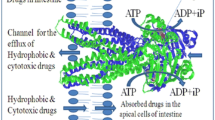Abstract
Purpose. P-glycoprotein-mediated transcellular transport of anticancer agents and the inhibitory effect of cyclosporin analogs and FK506 were investigated.
Methods. The transcellular transport of daunorubicin and vinblastine by monolayers of LLC-GA5-COL150 cells which overexpressed P-glycoprotein was measured in the presence and absence of cyclosporins or FK506.
Results. Cyclosporins and FK506 inhibited P-glycoprotein-mediated transport of daunorubicin and vinblastine in the order of cyclosporin D, dihydrocyclosporin D > cyclosporin A > FK506 > cyclosporin C, dihydrocyclosporin C. The intracellular accumulation of the anticancer agents was highly associated with the transporting function of P-glycoprotein. The inhibitory effect of cyclosporin D was concentration-dependent. The inhibitory effect of the modulators on P-glycoprotein was not correlated with the immunosuppressive activity, but was correlated with their lipophilicity.
Conclusions. In the transcellular transport system, lipophilicity may be one of the determinants for the inhibitory effect of various multidrug resistance modulators on the P-glycoprotein-mediated transport.
Similar content being viewed by others
REFERENCES
I. B. Roninson (ed.). Molecular and cellular biology of multidrug resistance in tumor cells, Plenum Press, New York, 1991.
M. M. Gottesman and I. Pastan. Biochemistry of multidrug resistance mediated by the multidrug transporter. Annu. Rev. Biochem. 62:385–427 (1993).
M. Hirai, K. Tanaka, T. Shimizu, Y. Tanigawara, M. Yasuhara, R. Hori, Y. Kakehi, O. Yoshida, K. Ueda, T. Komano, and K. Inui. Cepharanthin, a multidrug resistant modifier, is a substrate for P-glycoprotein. J. Pharmacol. Exp. Ther. 275:73–78 (1995).
L. M. Slater, P. Sweet, M. Stupecky, and S. Gupta. Cyclosporin A reverses vincristine and daunorubicin resistance in acute lymphatic leukemia in vitro. J. Clin. Invest. 77:1405–1408 (1986).
P. R. Twentyman. Cyclosporins as drug resistance modifiers. Biochem. Pharmacol. 43:109–117 (1992).
M. Naito, T. Oh-hara, A. Yamazaki, T. Danki, and T. Tsuruo. Reversal of multidrug resistance by an immunosuppressive agent FK506. Cancer Chemother. Pharmacol. 29:195–200 (1992).
Y. Tanigawara, N. Okamura, M. Hirai, M. Yasuhara, K. Ueda, N. Kioka, T. Komano, and R. Hori. Transport of digoxin by human P-glycoprotein expressed in a porcine kidney epithelial cell line (LLC-PK1). J. Pharmacol. Exp. Ther. 263:840–845 (1992).
P. M. Colombani, A. Robb, and A. D. Hess. Cyclosporin A binding to calmodulin: a possible site of action on T lymphocytes. Science 228:337–339 (1985).
V. F. J. Quesniaux, M. H. Schreier, R. M. Wenger, P. C. Hiestand, M. W. Harding, and M. H. V. Van Regenmortel. Cyclophilin binds to the region of cyclosporine involved in its immunosuppressive activity. Eur. J. Immunol. 17:1359–1365 (1987).
J. J. Siekierka, M. J. Staruch, S. H. Y. Hung, and N. H. Sigal. FK-506, a potent novel immunosuppressive agent, binds to a cytosolic protein which is distinct from the cyclosporin A-binding protein, cyclophilin. J. Immunol. 143:1580–1583 (1989).
T. Hoof, A. Demmer, U. Christians, and B. Tümmler. Reversal of multidrug resistance in Chinese hamster ovary cells by the immunosuppressive agent rapamycin. Eur. J. Pharmacol. 246:53–58 (1993).
I. Tamai and A. R. Safa. Competitive interaction of cyclosporins with the vinca alkaloid-binding site of P-glycoprotein in multidrug resistant cells. J. Biol. Chem. 265:16509–16513 (1990).
T. Saeki, K. Ueda, Y. Tanigawara, R. Hori, and T. Komano. Human P-glycoprotein transports cyclosporin A and FK506. J. Biol. Chem. 268:6077–6080 (1993).
P. F. Augustijns, T. P. Bradshaw, L-S. L. Gan, R. W. Hendren, and D. R. Thakker. Evidence for a polarized efflux system in Caco-2 cells capable of modulating cyclosporin A transport. Biochem. Biophys. Res. Comm. 197:360–365 (1993).
U. S. Rao and G. A. Scarborough. Direct demonstration of high affinity interactions of immunosuppressive drugs with the drug binding site of the human P-glycoprotein. Mol. Pharmacol. 45:773–776 (1994).
Author information
Authors and Affiliations
Rights and permissions
About this article
Cite this article
Tanaka, K., Hirai, M., Tanigawara, Y. et al. Effect of Cyclosporin Analogues and FK506 on Transcellular Transport of Daunorubicin and Vinblastine via P-glycoprotein. Pharm Res 13, 1073–1077 (1996). https://doi.org/10.1023/A:1016019010339
Issue Date:
DOI: https://doi.org/10.1023/A:1016019010339




